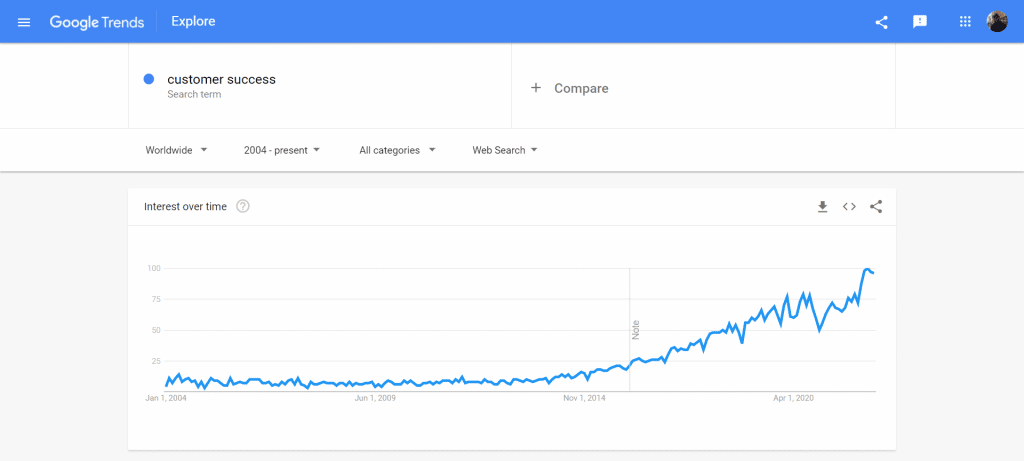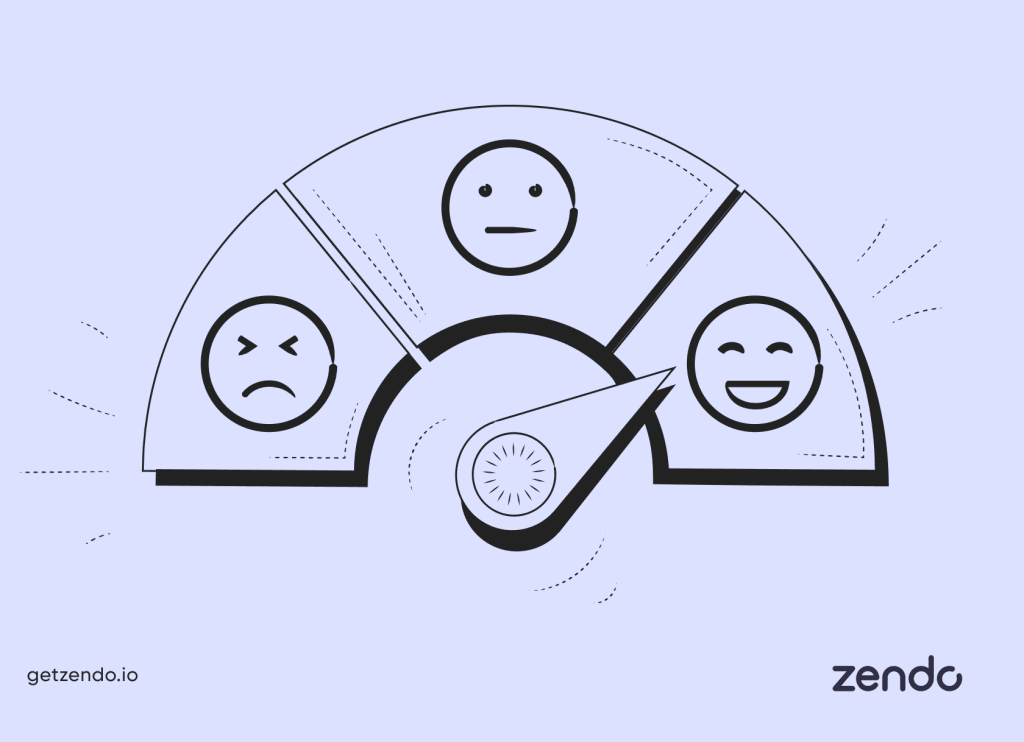Customer success vs customer experience — these two terms may confuse some people. After all, is one so different from the other? Or perhaps they are one and the same? Luckily, we’ve prepared an article that will help you understand the differences and similarities between the two!
What is Customer Success?

Customer success is a relatively new term that started gaining serious traction in 2014. Of course, its story began a lot earlier — i.e. — circa. 1995, but started growing in the 2000s. Along with the development of the Software as a Service industry, the demand for customer success grew. In the years 1996-1997, there were no customer success teams. After all, it was just a crawling idea that would become a really important factor for different brands nowadays. However, it’s an important date, as these were the years when the first customer success team emerged.
In the years to come, especially in 2004, the customer success ideology began to grow. It is when the first customer success management team has been created. The development continued across the years until it reached the present date, where customer success is one of the most important factors for SaaS businesses.

So what is customer success? It is one of the most important metrics and factors in the SaaS (Software as a Service) business. What matters the most in customer success focuses on the ability to retain customers at the end of the journey. So what exactly do customer success teams do?
First and foremost, the main goal of customer success teams is to know what customers want, their goals, and their desires. For a SaaS company, that would include creating onboardings, blog articles explaining the software, videos, guides, etc. What’s more, the teams along with customer success managers also need to foresee potential customer issues that may arise after the purchase and do their best to solve them beforehand. What’s also interesting about customer success is that teams can find opportunities for cross-selling or upselling whenever such situations arise. If a customer success team manages to do all that in a great fashion, it will definitely boost the customer value.
Best Example — Amazon
Amazon — Jeff Bezos’s company that reached heights no one would ever expect is probably a perfect example of a customer success story done right. The question is — how does Amazon manage to deliver the best customer journey possible?
The company provides its customers with a detailed and informative purchase system, along with speedy delivery (some items can even be delivered on the same day thanks to the Prime Delivery). To top all that, whenever a customer wants to gather more information, whether on the delivery or simply about the purchase or product, the customer service team is always there to support its client to the best of their abilities. And we can go on and on! Yet another thing that makes Amazon better than the rest of the competition is Amazon Prime which features various benefits (from faster and free delivery to gaming perks, video streaming service, ad-free music, and much more!).
To prove the point, all we have to do is look at some statistics. In a survey conducted by Feedvisor, in 2019 alone, almost 90% of clients in the United States are more likely to buy products from Amazon, than from any other e-commerce platform. That’s an outstanding number, don’t you think?
What is Customer Experience?

Customer experience mainly focuses on activities centered around creating a positive customer experience at every touchpoint in the entire customer journey. Again, what exactly are customer experience teams responsible for?
Among the many duties of the customer experience team, ones that are really important are direct interactions with customers (even at the beginning of the customer lifecycle), whether it’s a phone call, chat, or email message. It’s up to the team to make sure that customers leave satisfied with the service they received.
Best Example — Gaylord Opryland
Once upon a time, a long-time BlissDom conference attendee and a loyal Gaylord Opryland customer — Christina McMenemy, asked the resort about the clock she’s been using in her room. It wasn’t your ordinary clock, no. It was a special one that played Spa sounds to make your daily activities or nighttime more relaxing and soothing.
But let’s head back to the beginning, shall we?
When Christina first arrived at the resort, she was surprised by the clock radio and its soothing capabilities. The weekend passed and she decided to ask the resort’s staff where she could buy one for herself. Unfortunately, she soon found out that it’s not sold anywhere and is a resort exclusive clock.
Two years later, by the end of her third visit, Christina decided to take one last chance at obtaining the clock radio, so she twitted and tagged the Gaylord Opryland resort, asking about the clock radio and if it’s available to buy anywhere. Again, same result. But this time, the staff provided her with a model that features similar functionalities. To a sad surprise, it also didn’t feature the Spa sound and she made sure to let the resort know about this.
Little did she know that, meanwhile, when she was still attending the conference, the resort staff went into her room and delivered a second clock radio that Christina fell in love with. It also featured an annotation, that the second device is hers and she can take it home.
Now that’s a wonderful customer experience if you ask us!
Customer Success vs Customer Experience: Similarities and Correlations
There cannot be a winner of the customer success vs customer experience clash. Even though they are two different things, they often correlate with each other in many different fields, as the cooperation between the two teams is a vital component of a successful company. After all, the better the customer experience, the higher the customer success.
And there are more reasons for doing so! Customer experience and customer success work should also contribute to building a customer-centric culture. That will not only allow the teams to fulfill their goals but also help the company grow while at the same time establishing and maintaining a loyal customer base.
For example — at Zendo — our teams do their best to provide the best onboarding experience possible, while at the same time answering any potential questions that users may have.
Customer Success vs Customer Experience: Differences
As you can see above, the customer success vs customer experience battle results in quite a lot of things in common with each other. But how about their differences?
Well, CS and CX differ from each other in various stages — for example — onboarding, adoption, retention, and expansion, but also in metrics and industry. That being said, let’s focus on each of them.
Onboarding
Onboarding — an introductory stage for clients to get to know and understand the features of the product or service. You may say, there’s only one onboarding, so how can it be different? Well, we’re about to answer that!
When it comes to customer success, the team needs to prepare and share content that will fill certain places like Frequently Asked Questions, potential questions about product/service, etc. As we mentioned before, the CS team may in fact provide 1-1 onboarding with clients to make them understand the product or service better and answer their questions on the go.
Customer experience — on the other hand — requires the team members to be able to provide detailed explanations to issues raised or questions asked by clients, whether they are calls, messages, chats, follow-up emails, and so on.
Adoption
In the adoption stage, users spend a lot of time getting to know the product and how it operates. During this stage, they will decide whether they’ll want to use the product in the future and continue their subscription or not.
The responsibility of the customer success team in the adoption stage is to monitor how clients use the product or service, i.e., their behavior. Judging from that, the team should be able to discover and fix issues, as well as foresee future functionalities.
The customer experience team, however, should rather make sure that the adoption process goes smoothly, without unnecessary obstacles, while at the same time making sure that customers have enough materials they can learn from. If not, it’s the team’s job to provide them to the user.
Retention
We know, customer retention may sometimes be challenging, but let’s be honest, every company has to face it. The retention stage is all about making sure that customers won’t leave the service or product and remain a subscriber. So how should the teams in question handle it?
During the retention stage, a dedicated customer success team and the customer experience team gather information based on customer feedback. How? It’s simple! Teams usually send out an e-mail, survey, or any other form, to find out users’ thoughts about the product or service.
Expansion
We’re past the onboarding, adoption, and retention stages and are now heading to the expansion stage. It is the phase where teams need to think about expanding their offer — i.e. — adding more functionalities and features.
The customer success team should act based on the feedback gathered from the clients (finding selling opportunities, for example). What’s more, based on the gathered customer feedback, the team can actually compose pieces of writing. What we mean by that are case studies that showcase the user’s experience and thoughts about the product or service.
The customer experience team, on the other hand, can look into creating potential partnerships with people that can promote the brand — for example — influencers. If everything works out well, they can become the so-called brand ambassadors or brand advocates.
Metrics
Now, let’s proceed with a little bit different comparison. We’re going to shift our focus to metrics and industry.
The metrics that a customer success team would certainly use in their work would include ones like CLV (Customer Lifetime Value), churn rate, retention rate, and more. You can read about some of them in our article on Zendo dedicated to customer acquisition metrics.
How about the customer experience team? Well, they would rather concentrate on satisfaction scores, therefore, following metrics like CSAT (Customer Satisfaction Score), conversion rate, customer acquisition rate, CES (Customer Effort Score), or NPS (Net Promoter Score) would definitely be a great idea.
Industry
It’s now time to cover the industry subject and ask a question — in which industries can customer success and customer experience teams spread their wings? We’re about to find out.
Most commonly, a customer success team can be found in SaaS industries. The key factor here is that most Software as a Service companies offer a subscription-based model. Helping the user throughout the whole customer journey is a significant factor in the company’s growth.
When it comes to the customer experience team, they can be found in various companies, no matter the industry.
How to Improve Customer Experience Using Zendo
Now that we thoroughly understand the importance of taking care of customer experience, it’s time to discuss a few examples of how you can do that using a client portal.
Zendo is a simple yet fully customizable client portal software that helps businesses manage their clients’ request, keeping them up-to-date with status updates, offering built-in payment options, in-chat estimations, and many more features that enhance the efficiency while ensuring smooth customer experience.
Here are some of the many Zendo features that help businesses improve customer experience!
Zendo features that help improve customer experience
Follow-up message
A follow-up message feature in Zendo is an automatic message popping up in the chat immediately after the client submits a request. The message can be pre-defined to fit the Request Type the client selected and either share an overview of what’s going to happen next or ask any relevant questions.
Let’s present how this feature works using an example – let’s say you own a translation agency and have two types of requests that your clients usually submit:
- Custom Requests
- Productized Service Requests
If you want to speed up the whole process and make sure that your customers stay informed even at the beginning of their journey, you can set up an automatic follow-up message that will pop up after one of your clients sends a Custom Request.
Now if they usually ask for an estimation of a document they need to get translated, the follow-up message that pops up immediately after they fill out the Order Form (which, btw. is also customizable with the fields you find essential) – can inform the client that they will receive the estimation within the next 24 hours and ask them a few relevant to the estimation process questions, such as:
- How many words does the text to be translated contain?
- Which language pair do you want the text to have translated in?
- Is the language of the text considered general or are there any specific words/phrases or any technical or industry-specific terminology involved?
- Do you require the translation in a shorter time frame than the one specified in the service description?
You can also ask your clients to attach the text to be translated to make sure you’ll be able to properly estimate the costs.
Now how exactly is this feature improving customer experience you may ask? Well, the answer lies within the speed to lead factor.
Speed to lead statistics show that we are 21 times more likely to qualify a lead if we reply to the client within the first 30 minutes and can increase the conversions by 391% when replying within the first minute of receiving a message.
And since the follow-up message comes right after request submission – the time of response is immediate!
Productized Service and built-in payments
Productized Service and built-in payments is yet another example of Zendo features that will definitely help you improve the customer experience.
Why not stick with the translation agency example to help unravel these features!
Let’s imagine that we have a productized service of one general 500-word translation in EN-FR pair that costs $55 when charging $0.11 per word.
Your clients can submit a Productized Service Request by completing an Order Form with the information you set as essential to be provided (which may include choosing the productized service they’re interested in, an attachment of the text to be translated, and any additional details you find crucial).
The Request sent then pops into the Zendo dashboard and requires clients to pay for the productized service they have selected. In the case of the 500-word general text translation example – the cost is $55.
The payment comes upfront since the service was marked as a productized one, allowing you to receive payments quickly and the client to immediately cover the costs of the service instead of going through the estimation process.
Moreover, for smooth customer experience, the payment is built-in to the chat of the request, eliminating the need for clients to switch apps to cover the costs of the service they want to purchase.
Now to start using this feature, you need to set up the payment type preferred. When creating a new Request Type, you can choose one of the three available payment type options:
- None – perfect for support-dedicated inquiries or any requests that don’t include payment
- One-time – ideal for productized services or services with a stipulated upfront payment
- Custom – a payment option dedicated for custom service that requires an estimation to be made
Having one space for both communication and payments simplifies the whole customer journey, minimizing the places for interaction.
In-chat estimations
Another feature that greatly improves customer experience is the in-chat estimation feature that’s available for Zendo users.
This time around let us focus on a different example – an interior design agency that receives a ton of estimation requests. In a case like this, the process of estimating the service costs takes quite a bit of time and consists of many elements to go through.
The client needs to provide essential information for completing the estimation process, such as the type of room they want to get designed, the space to plan within, the materials and colors preferred, and any ideas they have for the space, which with Zendo they can easily do so in the customizable Order Form embedded on your website.
The point is that interior designers then have to come up with the total cost based on the information provided and get back to the client as quickly as possible.
Now to make this process more efficient and avoid the unnecessary hassle – Zendo offers both customizable Order Forms and in-chat estimations that don’t require changing the communication channel at all!
With Zendo – you simply create an estimate within the chat that pops up in the conversation for the client to see.
Status Updates
The last, but surely not the least important feature we’ll go over is the Status feature.
Zendo allows you to keep your clients informed at all times with custom statuses that may be triggered automatically or set manually by one of your team agents.
Think of the status updates this way – whenever you order a package from Amazon or request an Uber ride – you immediately start tracing your order. Whether that’s a new set of comfy socks being delivered or an Uber ride coming to take you to a meeting you need to get to – you will be tracing it till it reaches you.
Real-time order tracking made 87.4% of clients enjoy the process of purchasing more rather than not having this option.
And that’s because we want to know how our order is doing and most importantly, when it will reach us.
Status updates are significant in improving the customer experience, especially in a service-based business since they make sure that your client stays well informed throughout the whole process, even if it’s a complicated one!
Zendo gives you a set of various ready-made status updates, such as New, Evaluating, Awaiting Payment, Paid, In Progress, Done, and many many more. Moreover, you can also come up with your own statuses specific to your service or business. All you need to do is head to Settings in your Zendo account and set a new status’ name, adjust the color, and create its description.
Status updates are visible to clients within the request chat, as well as right next to the chat thread where the essential request information is displayed. Your clients will also get a notification each time a status of their request has been changed, keeping them updated at all times.
Timely responses and on-hand information availability is definitely something that helps us maintain good customer relationships. Moreover, using one platform to communicate with the client, send estimations, complete payments, and update them on the status of the request, without the need to switch apps, is another level of meeting the clients’ needs.
Now that’s something that shouldn’t be left to fate! Take care of improving customer experience with Zendo today by trying the free version of the app!
Conclusions
And here we are! We’ve gone through explaining the customer success vs customer experience issue, through their best examples, all the way to similarities and differences in responsibilities of both teams. We have also presented some of the Zendo features that improve customer experience to showcase the effectiveness of using a client portal for this purpose.
Now, we’ve reached the end of this not-so-long article and we hope that you are now able to successfully tell the difference between both, the customer success and customer experience teams.
If you have any questions regarding the customer success vs customer experience subject or Zendo in general, we’ll be more than happy to assist you! See you next time!

A free online training. Delivered daily to your inbox to grow your productized agency.











